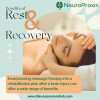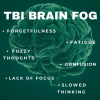Disinhibition is a behavioral change that can be seen after a brain injury, particularly after damage to the frontal lobe area. When this occurs, an individual is unable inhibit or control socially inappropriate thoughts, emotions, and behaviors. Their inability to filter themselves affects them emotionally and socially, making it challenging to follow social norms and established rules. Their actions as a result of their disinhibition have been described by others as being insensitive towards others, immature, and can pose as a challenge to maintain or form new relationships with others.
Disinhibition may look like either of the following signs:
- Engaging in aggressive or risky behaviors
- Being impulsive in their decisions
- Laughing at inappropriate times
- Being overly friendly towards others including strangers
- Oversharing information with others
- Speaking their mind before thinking
- Being sexually inappropriate with others
- Speaking from an egocentric perspective (e.g., selfishness, childishness, or arguing)
Not only does this impact the brain injury survivor but can be distressing for families may not fully understand the causes of this new behavioral issue. The individual may feel isolated and disconnected from others, which can lead to depression or anxiety. Unfortunately, this can lead to a decrease in their life satisfaction, difficulties integrating back into their community, or experiencing possible legal problems. One study found that six and twelve months after experiencing a BI, individuals experienced suicidal ideations. Although it can become a serious problem, there is hope on recovering from their disinhibition. The following treatments and strategies are listed below:
| Strategies or Treatments: There are no known published treatment strategies specifically for disinhibition from TBI. |
|
References:
Osborne-Crowley, K., McDonald, S., & Francis, H. (2016). Development of an observational measure of social disinhibition after traumatic brain injury. Journal of Clinical & Experimental Neuropsychology, 38(3), 341–353. https://doi-org.westcoastuniversity.idm.oclc.org/10.1080/13803395.2015.1115824
Osborne-Crowley, K., & McDonald, S. (2018). A review of social disinhibition after traumatic brain injury. Journal of Neuropsychology, 12(2), 176–199. https://doi-org.westcoastuniversity.idm.oclc.org/10.1111/jnp.12113
FlintRehab. (2010). Disinhibition after brain injury: Causes, treatment, and management. FlintRehab. https://www.flintrehab.com/disinhibition-after-brain-injury/
Kim, E. (2002). Agitation, aggression, and disinhibition syndromes after traumatic brain injury. NeuroRehabilitation, 17(4), 297–310. https://doi-org.westcoastuniversity.idm.oclc.org/10.3233/nre-2002-17404



